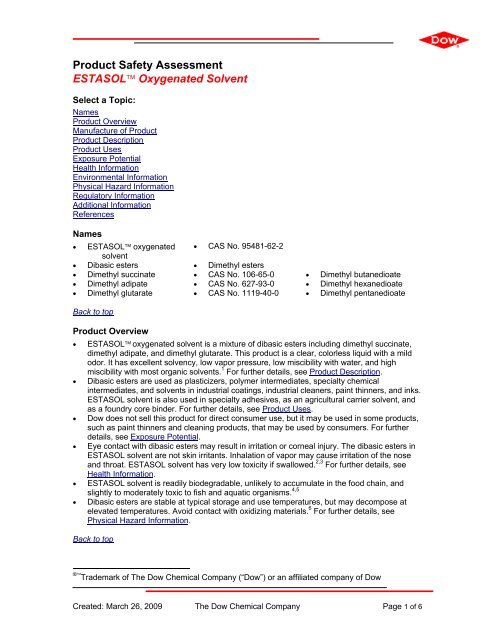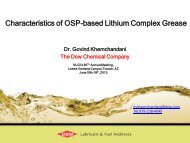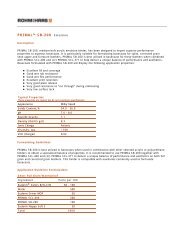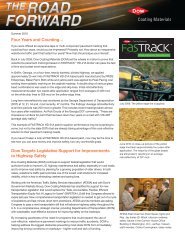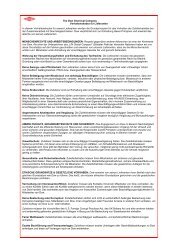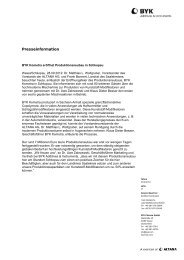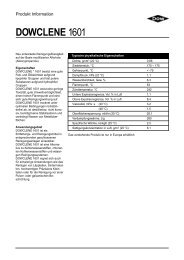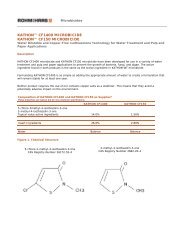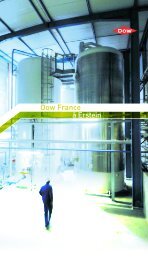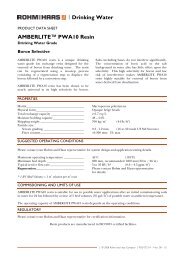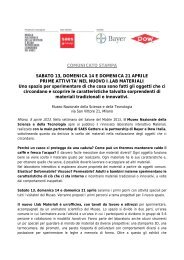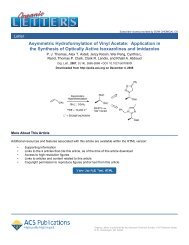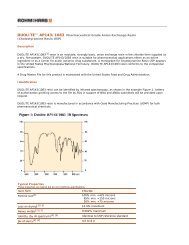Product Safety Assessment ESTASOL⢠Oxygenated Solvent
Product Safety Assessment ESTASOL⢠Oxygenated Solvent
Product Safety Assessment ESTASOL⢠Oxygenated Solvent
Create successful ePaper yourself
Turn your PDF publications into a flip-book with our unique Google optimized e-Paper software.
<strong>Product</strong> <strong>Safety</strong> <strong>Assessment</strong><br />
ESTASOL <strong>Oxygenated</strong> <strong>Solvent</strong><br />
Select a Topic:<br />
Names<br />
<strong>Product</strong> Overview<br />
Manufacture of <strong>Product</strong><br />
<strong>Product</strong> Description<br />
<strong>Product</strong> Uses<br />
Exposure Potential<br />
Health Information<br />
Environmental Information<br />
Physical Hazard Information<br />
Regulatory Information<br />
Additional Information<br />
References<br />
Names<br />
• ESTASOL oxygenated<br />
solvent<br />
• CAS No. 95481-62-2<br />
• Dibasic esters • Dimethyl esters<br />
• Dimethyl succinate • CAS No. 106-65-0 • Dimethyl butanedioate<br />
• Dimethyl adipate • CAS No. 627-93-0 • Dimethyl hexanedioate<br />
• Dimethyl glutarate • CAS No. 1119-40-0 • Dimethyl pentanedioate<br />
Back to top<br />
<strong>Product</strong> Overview<br />
• ESTASOL oxygenated solvent is a mixture of dibasic esters including dimethyl succinate,<br />
dimethyl adipate, and dimethyl glutarate. This product is a clear, colorless liquid with a mild<br />
odor. It has excellent solvency, low vapor pressure, low miscibility with water, and high<br />
miscibility with most organic solvents. 1 For further details, see <strong>Product</strong> Description.<br />
• Dibasic esters are used as plasticizers, polymer intermediates, specialty chemical<br />
intermediates, and solvents in industrial coatings, industrial cleaners, paint thinners, and inks.<br />
ESTASOL solvent is also used in specialty adhesives, as an agricultural carrier solvent, and<br />
as a foundry core binder. For further details, see <strong>Product</strong> Uses.<br />
• Dow does not sell this product for direct consumer use, but it may be used in some products,<br />
such as paint thinners and cleaning products, that may be used by consumers. For further<br />
details, see Exposure Potential.<br />
• Eye contact with dibasic esters may result in irritation or corneal injury. The dibasic esters in<br />
ESTASOL solvent are not skin irritants. Inhalation of vapor may cause irritation of the nose<br />
and throat. ESTASOL solvent has very low toxicity if swallowed. 2,3 For further details, see<br />
Health Information.<br />
• ESTASOL solvent is readily biodegradable, unlikely to accumulate in the food chain, and<br />
slightly to moderately toxic to fish and aquatic organisms. 4,5<br />
• Dibasic esters are stable at typical storage and use temperatures, but may decompose at<br />
elevated temperatures. Avoid contact with oxidizing materials. 6 For further details, see<br />
Physical Hazard Information.<br />
Back to top<br />
® Trademark of The Dow Chemical Company (“Dow”) or an affiliated company of Dow<br />
Created: March 26, 2009 The Dow Chemical Company Page 1 of 6
<strong>Product</strong> <strong>Safety</strong> <strong>Assessment</strong>: ESTASOL <strong>Oxygenated</strong> <strong>Solvent</strong><br />
Manufacture of <strong>Product</strong><br />
• Process – Dibasic esters are produced by reacting a mixed stream of adipic, glutaric, and<br />
succinic (AGS) acids with methanol under acidic conditions, followed by distillation to recover<br />
the mixed dibasic esters. The reaction is shown below.<br />
HO<br />
HO<br />
HO<br />
Back to top<br />
O<br />
O<br />
O<br />
Adipic acid<br />
Glutaric acid<br />
O<br />
O<br />
O<br />
OH<br />
OH<br />
CH 3OH<br />
acid<br />
H3CO<br />
H3CO<br />
H3CO<br />
OCH3<br />
Created: March 26, 2009 The Dow Chemical Company Page 2 of 6<br />
O<br />
O<br />
Dimethyl glutarate<br />
O O<br />
OH<br />
OCH3 Succinic acid Dimethyl succinate<br />
O<br />
Dimethyl adipate<br />
O<br />
OCH 3<br />
<strong>Product</strong> Description 7,8<br />
ESTASOL oxygenated solvent is a mixture of dimethyl succinate (CAS No. 106-65-0, 15–25%),<br />
dimethyl adipate (CAS No. 627-93-0, 12–23%), and dimethyl glutarate (CAS No. 1119-40-0, 55–<br />
65%). The product is a clear, colorless liquid with a mild odor and has excellent solvency, low<br />
vapor pressure, low miscibility with water, and high miscibility with most organic solvents. It is<br />
marketed for Dow Haltermann Custom Processing through a variety of distributors.<br />
Back to top<br />
<strong>Product</strong> Uses 9,10<br />
Dibasic esters are used as plasticizers, polymer intermediates, specialty chemical intermediates,<br />
and solvents in industrial coatings, industrial cleaners, paint thinners, and inks.<br />
ESTASOL oxygenated solvent is used in can and coil coatings, foundry core binders, acrylic<br />
lacquers, wood finishes, printing inks, and paint strippers. It is also used in various industrial<br />
cleaning applications, including metal degreasing, GRP-resin (glass reinforced plastic) cleaning,<br />
hand cleaning, etc., as well as in grouting, sealants and wax formulations. ESTASOL oxygenated<br />
solvent is often blended with other solvents to provide optimization of properties in formulations.<br />
Back to top<br />
Exposure Potential 11,12<br />
Dibasic esters are used in the production of industrial and consumer products. Based on the uses<br />
for these products, the public could be exposed through:<br />
• Workplace exposure – Exposure can occur either in a dibasic esters manufacturing facility<br />
or in the various industrial or manufacturing facilities that use this product. It is produced,<br />
distributed, stored, and consumed in closed systems. Those working with this product in<br />
manufacturing operations could be exposed during maintenance, sampling, testing, or other<br />
procedures. Each manufacturing facility should have a thorough training program for<br />
employees and appropriate work processes and safety equipment in place to limit<br />
® Trademark of The Dow Chemical Company (“Dow”) or an affiliated company of Dow
<strong>Product</strong> <strong>Safety</strong> <strong>Assessment</strong>: ESTASOL <strong>Oxygenated</strong> <strong>Solvent</strong><br />
unnecessary exposure. The U.S. Environmental Protection Agency (EPA) has completed an<br />
initial risk-based prioritization of the High <strong>Product</strong>ion Volume Chemicals, including the dibasic<br />
esters category. The U.S. EPA assumes that there are potential exposures to<br />
manufacturers, commercial workers and/or consumers from the use of products containing<br />
dibasic esters, with paint stripping uses presenting the potential for high exposures to<br />
individuals working in poorly ventilated areas. Available data used in the EPA’s assessment<br />
suggests a low concern for potential risk to [manufacturing] workers, but a medium concern<br />
for potential risk to commercial workers and consumers. See Health Information.<br />
• Consumer exposure to products containing dibasic esters – Dow does not sell this<br />
product for direct consumer use, but it may be used in some products, such as paint thinners<br />
and coatings, that are used by consumers. The U.S. EPA concluded that the risk for<br />
exposure to the general population from environmental releases is low. The potential risk to<br />
children as a subset of the general consumer population is considered low given that the<br />
typical consumer uses of dibasic esters do not involve children. See Health Information.<br />
• Environmental releases – Dibasic esters may be released to air by evaporation from<br />
cleaners, paint thinners and strippers, coatings and other products containing them.<br />
However, because they are highly soluble, once introduced to water, dibasic esters will tend<br />
to remain dissolved in water. Because the compounds are readily biodegradable, they will be<br />
removed by sewage treatment plants. In the event of a spill, the focus is on containing the<br />
spill to prevent contamination of soil and surface or ground water. For small spills, the product<br />
should be absorbed with materials such as sand or sawdust. Collect recovered material in<br />
properly labeled containers and dispose of it according to applicable government<br />
requirements. See Environmental, Health, and Physical Hazard Information.<br />
• Large release – Industrial spills or releases are infrequent and generally contained. If a large<br />
spill does occur, the material should be captured, collected, and reprocessed or disposed of<br />
according to applicable governmental requirements. An approved respirator with an organic<br />
vapor cartridge is recommended for emergency work. See Environmental and Physical<br />
Hazard Information.<br />
• In case of fire – Isolate the fire and deny unnecessary entry into the area. Use water spray<br />
or fog, dry-chemical or carbon-dioxide extinguishers, or foam to extinguish the fire. Use of a<br />
direct water stream may spread fire. Firefighters should wear positive pressure, selfcontained<br />
breathing apparatus (SCBA) and protective fire-fighting clothing. Follow emergency<br />
procedures carefully. See Health and Physical Hazard Information.<br />
For more information, see the relevant <strong>Safety</strong> Data Sheet.<br />
Back to top<br />
Health Information 13,14<br />
Eye contact with dibasic esters may result in irritation or corneal injury. These materials are not<br />
skin irritants. Prolonged skin contact is unlikely to result in absorption of harmful amounts.<br />
Inhalation of vapor may cause irritation of the nose and throat. Dibasic esters have very low<br />
toxicity if swallowed; swallowing amounts incidental to normal handling is not harmful. However,<br />
swallowing may result in gastrointestinal irritation. ESTASOL oxygenated solvent is not<br />
mutagenic nor is it a reproductive or developmental toxicant.<br />
For more information, see the relevant <strong>Safety</strong> Data Sheet.<br />
Back to top<br />
® Trademark of The Dow Chemical Company (“Dow”) or an affiliated company of Dow<br />
Created: March 26, 2009 The Dow Chemical Company Page 3 of 6
<strong>Product</strong> <strong>Safety</strong> <strong>Assessment</strong>: ESTASOL <strong>Oxygenated</strong> <strong>Solvent</strong><br />
Environmental Information 15,16<br />
Dibasic esters are moderately volatile, and may evaporate from products containing them.<br />
However, because they are highly soluble in water, once introduced, they have a tendency to<br />
remain in water. Dibasic esters have minimal tendency to bind to soil or sediment.<br />
Dibasic esters are unlikely to persist in the environment. The compounds are readily<br />
biodegradable, which suggests they will be rapidly and completely removed from water and soil<br />
environments, including biological wastewater treatment plants.<br />
Dibasic esters are not likely to accumulate in the food chain (bioconcentration potential is low)<br />
and are slightly to moderately toxic to fish and other aquatic organisms on an acute basis.<br />
The U.S. EPA risk-based prioritization of the dibasic esters assumes that there is potential for<br />
exposure to aquatic organisms from environmental releases. However, the low acute aquatic<br />
hazard and the overall environmental fate characteristics (e.g., not persistent or bioaccumulative)<br />
of all members of the dibasic esters category suggests a low concern for potential risk to aquatic<br />
organisms from environmental releases. Supporting documents can be accessed at the following<br />
links: Dibasic esters Web RBP 031308 (PDF) and Dibasic esters Web Support Docs<br />
031808 (PDF)<br />
For more information, see the relevant <strong>Safety</strong> Data Sheet.<br />
Back to top<br />
Physical Hazard Information 17<br />
Dibasic esters are stable at typical storage and use temperatures, but may decompose at<br />
elevated temperatures. Avoid contact with oxidizing materials.<br />
For more information, see the relevant <strong>Safety</strong> Data Sheet.<br />
Back to top<br />
Regulatory Information<br />
Regulations may exist that govern the manufacture, sale, transportation, use, and/or disposal of<br />
dibasic esters. These regulations may vary by city, state, country, or geographic region.<br />
Information may be found by consulting the relevant <strong>Safety</strong> Data Sheet or Contact Us.<br />
Back to top<br />
Additional Information<br />
• <strong>Safety</strong> Data Sheet<br />
• Contact Us (http://www.dow.com/custproc/contact/index.htm)<br />
• “ESTASOL – Higher Purity Dibasic Ester from Dow Haltermann Custom Processing,”<br />
Multisol Group Ltd., Greater Manchester, England, (http://www.multisolgroup.com/Estasolhigher-purity-DBE-from-Dow-Haltermann.pdf)<br />
• U.S. Environmental Protection Agency HPV Information System website – search relevant<br />
CAS No. (http://www.epa.gov/chemrtk/hpvis/index.html,<br />
http://www.epa.gov/hpvis/rbp/Dibasic%20esters.Web.RBP.031308.pdf,<br />
http://www.epa.gov/hpvis/rbp/Dibasic%20esters.Web.SupportDocs.031808.pdf)<br />
For more business information about ESTASOL dibasic esters, visit the Dow Haltermann Custom<br />
Processing web site at http://www.dow.com/custproc/.<br />
Back to top<br />
® Trademark of The Dow Chemical Company (“Dow”) or an affiliated company of Dow<br />
Created: March 26, 2009 The Dow Chemical Company Page 4 of 6
<strong>Product</strong> <strong>Safety</strong> <strong>Assessment</strong>: ESTASOL <strong>Oxygenated</strong> <strong>Solvent</strong><br />
References<br />
1 ESTASOL [<strong>Oxygenated</strong> <strong>Solvent</strong>] Material Data <strong>Safety</strong> Sheet, The Dow Chemical Company,<br />
5/23/07, page 3.<br />
2 ESTASOL [<strong>Oxygenated</strong> <strong>Solvent</strong>] Material Data <strong>Safety</strong> Sheet, The Dow Chemical Company,<br />
5/23/07, pages 1 and 4.<br />
3 U.S. Environmental Protection Agency High <strong>Product</strong>ion Volume Information System.<br />
(http://www.epa.gov/chemrtk/hpvis/index.html,<br />
http://www.epa.gov/hpvis/rbp/Dibasic%20esters.Web.RBP.031308.pdf,<br />
http://www.epa.gov/hpvis/rbp/Dibasic%20esters.Web.SupportDocs.031808.pdf)<br />
4 U.S. Environmental Protection Agency High <strong>Product</strong>ion Volume Information System.<br />
(http://www.epa.gov/chemrtk/hpvis/index.html,<br />
http://www.epa.gov/hpvis/rbp/Dibasic%20esters.Web.RBP.031308.pdf,<br />
http://www.epa.gov/hpvis/rbp/Dibasic%20esters.Web.SupportDocs.031808.pdf)<br />
5 ESTASOL [<strong>Oxygenated</strong> <strong>Solvent</strong>] Material Data <strong>Safety</strong> Sheet, The Dow Chemical Company,<br />
5/23/07, page 5.<br />
6 ESTASOL [<strong>Oxygenated</strong> <strong>Solvent</strong>] Material Data <strong>Safety</strong> Sheet, The Dow Chemical Company,<br />
5/23/07, pages 3 and 4.<br />
7 ESTASOL [<strong>Oxygenated</strong> <strong>Solvent</strong>] Material Data <strong>Safety</strong> Sheet, The Dow Chemical Company,<br />
5/23/07, pages 1, 2, and 3–4.<br />
8 “ESTASOL – Higher Purity Dibasic Ester from Dow Haltermann Custom Processing,” Multisol<br />
Group Ltd., Greater Manchester, England, page 1.<br />
9 Technical Data Sheet ESTASOL HP <strong>Oxygenated</strong> <strong>Solvent</strong>s, The Dow Chemical Company,<br />
Form No. 114-00061, June, 2008.<br />
10 The Dow Chemical Company: Dow Haltermann Custom Processing <strong>Product</strong>s: ESTASOL<br />
<strong>Oxygenated</strong> <strong>Solvent</strong>s.<br />
(http://www.dow.com/custproc/products/estasol.htm)<br />
11 ESTASOL [<strong>Oxygenated</strong> <strong>Solvent</strong>] Material Data <strong>Safety</strong> Sheet, The Dow Chemical Company,<br />
5/23/07, pages 2 and 3.<br />
12 U.S. Environmental Protection Agency High <strong>Product</strong>ion Volume Information System.<br />
((http://www.epa.gov/chemrtk/hpvis/index.html,<br />
http://www.epa.gov/hpvis/rbp/Dibasic%20esters.Web.RBP.031308.pdf,<br />
http://www.epa.gov/hpvis/rbp/Dibasic%20esters.Web.SupportDocs.031808.pdf))<br />
13 ESTASOL [<strong>Oxygenated</strong> <strong>Solvent</strong>] Material Data <strong>Safety</strong> Sheet, The Dow Chemical Company,<br />
5/23/07, pages 1 and 4.<br />
14 U.S. Environmental Protection Agency High <strong>Product</strong>ion Volume Information System.<br />
(http://www.epa.gov/chemrtk/hpvis/index.html,<br />
http://www.epa.gov/hpvis/rbp/Dibasic%20esters.Web.RBP.031308.pdf,<br />
http://www.epa.gov/hpvis/rbp/Dibasic%20esters.Web.SupportDocs.031808.pdf)<br />
15 ESTASOL [<strong>Oxygenated</strong> <strong>Solvent</strong>] Material Data <strong>Safety</strong> Sheet, The Dow Chemical Company,<br />
5/23/07, pages 4–5.<br />
16 U.S. Environmental Protection Agency High <strong>Product</strong>ion Volume Information System.<br />
(http://www.epa.gov/chemrtk/hpvis/index.html,<br />
http://www.epa.gov/hpvis/rbp/Dibasic%20esters.Web.RBP.031308.pdf,<br />
http://www.epa.gov/hpvis/rbp/Dibasic%20esters.Web.SupportDocs.031808.pdf)<br />
17 ESTASOL [<strong>Oxygenated</strong> <strong>Solvent</strong>] Material Data <strong>Safety</strong> Sheet, The Dow Chemical Company,<br />
5/23/07, pages 3 and 4.<br />
Back to top<br />
® Trademark of The Dow Chemical Company (“Dow”) or an affiliated company of Dow<br />
Created: March 26, 2009 The Dow Chemical Company Page 5 of 6
<strong>Product</strong> <strong>Safety</strong> <strong>Assessment</strong>: ESTASOL <strong>Oxygenated</strong> <strong>Solvent</strong><br />
NOTICES:<br />
As part of its 2015 Sustainability Goals, Dow has committed to make publicly available safety<br />
assessments for its products globally. This product safety assessment is intended to give general<br />
information about the chemical (or categories of chemicals) addressed. It is not intended to<br />
provide an in-depth discussion of health and safety information. Additional information is available<br />
through the relevant <strong>Safety</strong> Data Sheet, which should be consulted before use of the chemical.<br />
This product safety assessment does not replace required communication documents such as<br />
the <strong>Safety</strong> Data Sheet.<br />
The information herein is supplied upon the condition that the persons receiving same will make<br />
their own determination as to its suitability for their purposes prior to use. In no event will Dow be<br />
responsible for damages of any nature whatsoever resulting from the use of or reliance upon the<br />
information herein or the product to which that information refers.<br />
Nothing contained herein is to be construed as a recommendation to use any product, process,<br />
equipment or formulation in conflict with any patent, and Dow makes no representation or<br />
warranty, express or implied, that the use thereof will not infringe any patent.<br />
NO REPRESENTATIONS OR WARRANTIES, EITHER EXPRESS OR IMPLIED, OF<br />
MERCHANTABILITY, FITNESS FOR A PARTICULAR PURPOSE OR OF ANY OTHER<br />
NATURE ARE MADE HEREUNDER WITH RESPECT TO INFORMATION OR THE PRODUCT<br />
TO WHICH INFORMATION REFERS.<br />
Dow makes no commitment to update or correct any information that appears on the Internet or<br />
on its World-Wide Web server. The information contained in this document is supplemental to the<br />
Internet Disclaimer, http://www.dow.com/homepage/disclosure.html.<br />
Back to top<br />
Form No. 233-00565-MM-0309<br />
Created: March 26, 2009 The Dow Chemical Company Page 6 of 6


